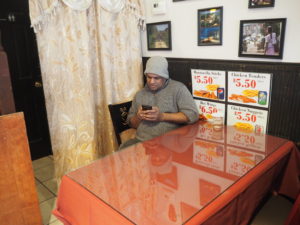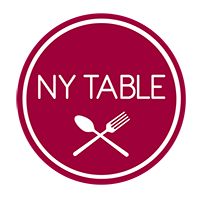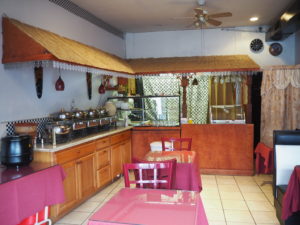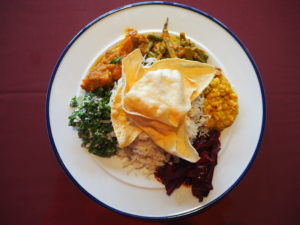As Mahesh Bandara strides into Ceylon Curry, his father’s Sri Lankan restaurant in Staten Island, he glances at the middle-aged men in the corner, who are speaking Sinhalese. These regulars sit beneath framed photographs of ancient temples and wild elephants on dusty earth roads – scenes from their homeland, to which some hope to return.
“Everybody here is friends,” said Vijitha Dombagammana, the owner of the establishment and 26-year-old Bandara’s father. Originally from Kandy, the apron-clad Dombagammana usually stands behind the cashier to greet patrons. To his right, a pristine white Buddha sits at a small altar. Dombagammana smiled as he opened his arms and said, “There are 15,000 Sri Lankans here!”
“Here” refers to Little Sri Lanka, which is concentrated in the Tompskinville and St. George neighborhoods of Staten Island. A study by CUNY in 2014 recorded approximately 5,000 Sri Lankans living in Staten Island, a third of Dombagammana’s estimation. Still, according to the Department of Homeland Security’s immigration statistics, New York City has the largest Sri Lankan population nationwide, and Staten Island is home to the largest community outside of Sri Lanka itself.

Vijitha Dombagammana spends his time between the restaurant and Ceylon Grocery, which is across the road. Photo: Aisha Hassan.
Ceylon Curry is at 324 Victory Boulevard in the heart of Tompkinsville, and is surrounded by a host of other Sri Lankan restaurants and groceries. Many of these, including Ceylon Curry and Ceylon Grocery – a food store across the street that Dombagammana also owns – have been passed from one immigrant to another as they choose to return home.
Bandara and his mother first moved to the United States in 2007, sponsored by a relative in Oregon, before his father joined them a year later. When he first arrived, Bandara continued his education at the Susan E. Wagner High School in Staten Island. Later, he majored in mechanical engineering at the College of Staten Island, eventually graduating from Lincoln Tech in New Jersey.
The elder Dombagammana started as a cook at Ceylon Curry as soon as he arrived in 2008, and took it over in 2013. He said that he “had no choice” but to take ownership after the previous Sri Lankan owner left. Dombagammana was not only already familiar with running the restaurant, but he also saw it as a significant business opportunity.
Six months ago, Dombagamanna also took charge of Ceylon Grocery, which Bandara now runs. “It used to be owned by another Sri Lankan family,” Bandara said, but his father bought it for a “good price” after they decided to leave.
These establishments appear to be key parts of the community, judging by the many Sri Lankans who walk into Ceylon Curry just to have a conversation before leaving without so much as a hopper (a bowl-shaped pancake made from fermented rice flour). Whenever Dombagammana slips into Sinhalese, which he often does while finishing a long thought, several of them step in to translate without missing a beat.
The small size of the restaurant – only five tables and 16 seats – elevates the intimate atmosphere. While most customers get their food to go, some regulars, like Rajan Nagarejah, take the time to sit and eat. Nagarejah, who used to work in a government advertising department in Sri Lanka, now has two jobs, as a cashier at Dunkin’ Donuts and also at McDonalds.
Nilendra Jayasuntara is also a frequent patron of Ceylon Curry. In fact, he lives in an apartment above the restaurant. Jayasuntara works 12-hour stretches at a nearby gas station, splitting his week between midday and dawn shifts. Sometimes, on days that he finishes after midnight, Dombagammana will leave a bag of food waiting for him outside his apartment. Curried chicken, perhaps, or warm chickpea dal.
For Jayasuntara, spicy Sri Lankan food is both a comfort after long hours and a nostalgic reminder of home. “The smell of my childhood and my mother’s cooking is something I will never have again.” Tired after a long day, he rubbed his eyes and said that he plans to move back to Colombo, Sri Lanka by 2020. “Here is not my home.”
Even with two successful enterprises, Dombagammana seems to feel the same way. “I don’t want to stay a long time,” he said.
But the success of the businesses might keep the family here longer, at least in Bandara’s view. “We came here with nothing, basically scratch,” he said. Even if his father does leave, Bandara is prepared to take control of the family’s enterprises. He intends to return home this year to get married, but plans to bring his wife back as soon as possible. Having spent his formative years in America, unlike his father and his father’s friends, Bandara sees more potential here.
“I’d rather work for myself than for somebody else. And you know, things are good now.”



Your Comments